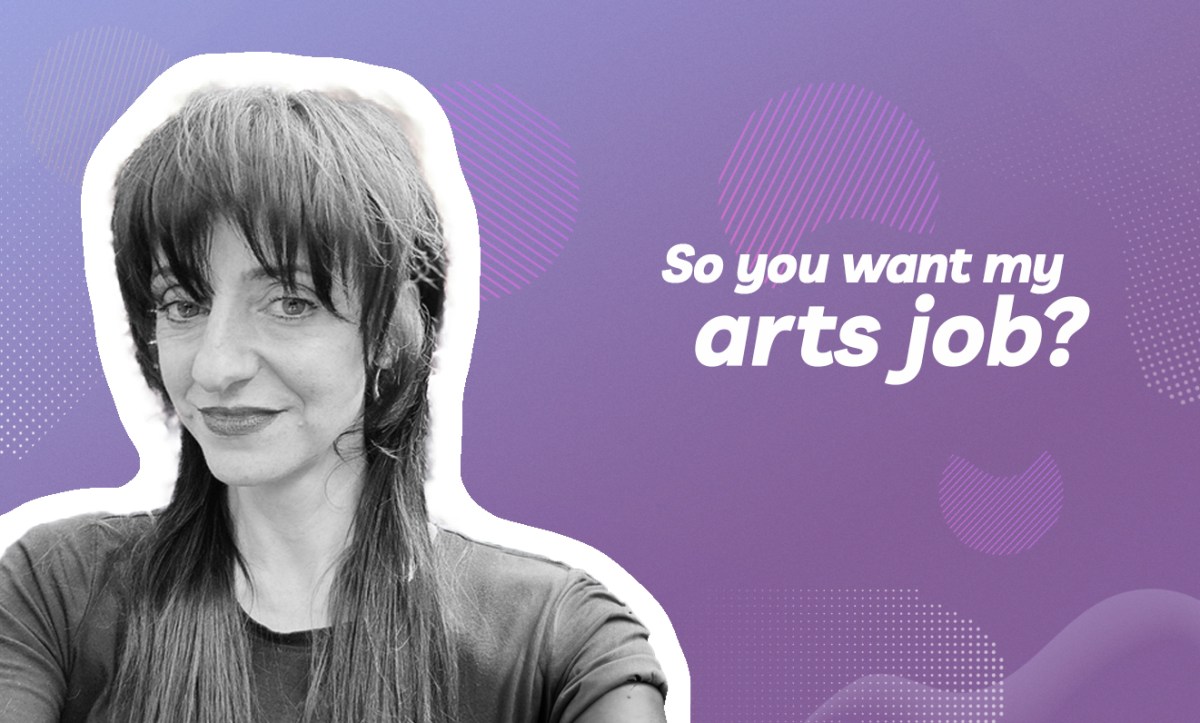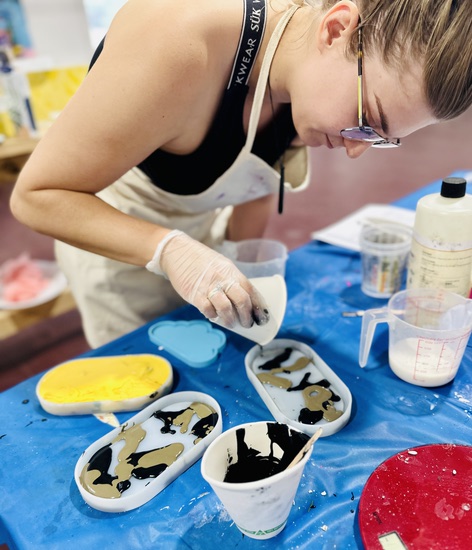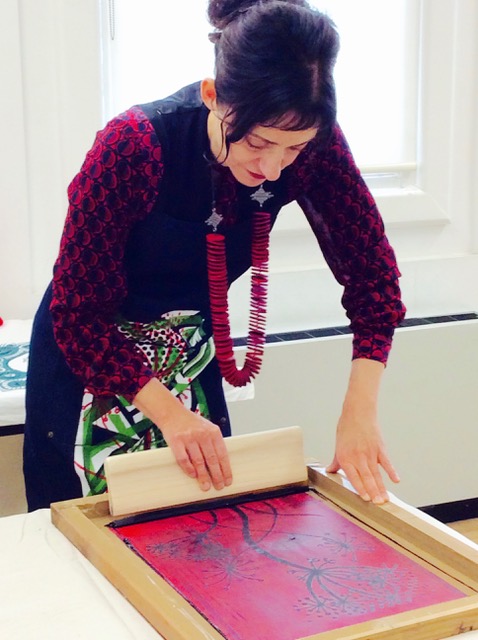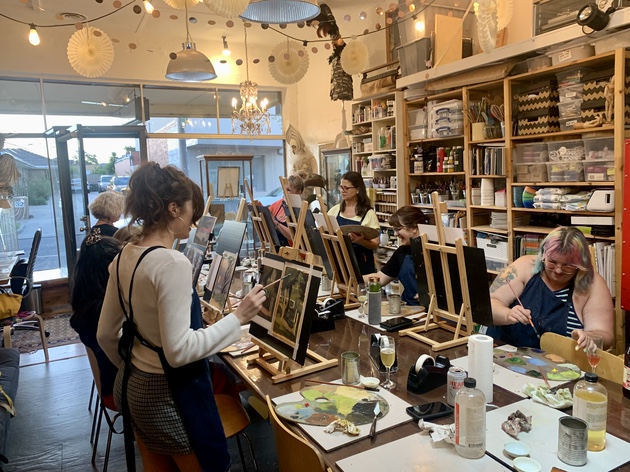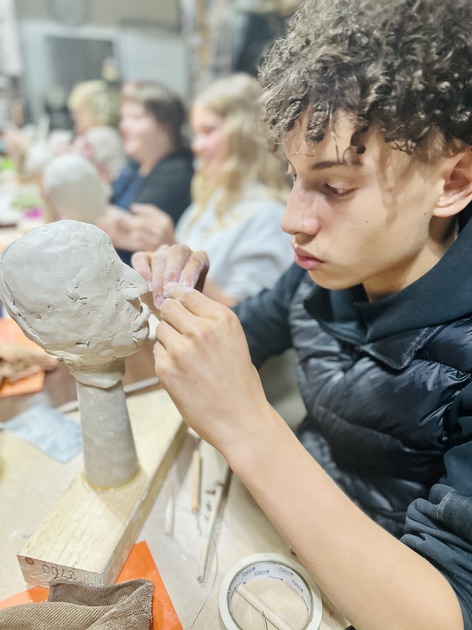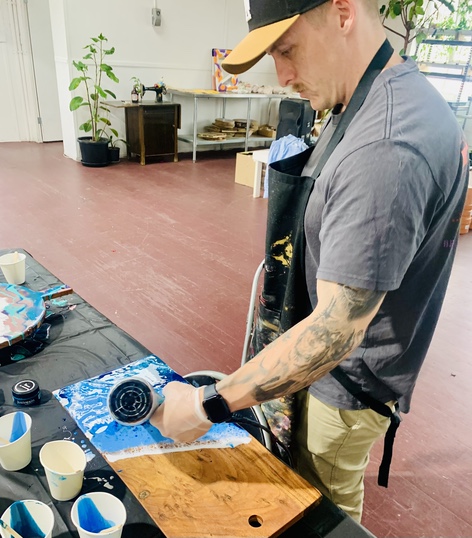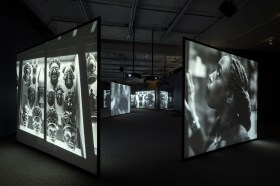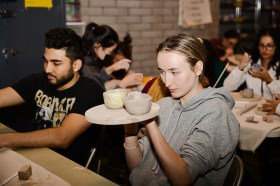Creating and making stunning wearable art comes naturally to Anna Kolusniewski, who is recognised as one of Australia’s leading costume jewellery designers, specialising in theatrical, period and recycled styles. Check out her Instagram for some of her amazing headpieces and costumes, including designs made from bottle tops, cable ties and even recycled rubber car mats.
Over the past three decades her work has featured in numerous magazine shoots and exhibitions, and was memorably highlighted in the 2020 Art and Industry Festival, and in the 2021 experimental post-lockdown immersive dining experience Higher Order.
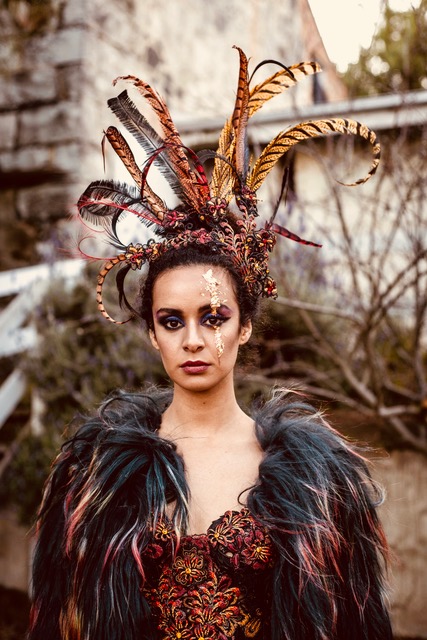
But after a long career as a designer, Kolusniewski set up Aa is for Art in Melbourne around 15 years ago. There she runs term-based visual arts and holiday programs for children, and workshops for adults. She also teaches at other institutions, including many not-for-profit and government-funded organisations that run art therapy programs. An expanding part of her business is in the crafting of bespoke corporate art classes for team building and fun in the workplace. (A note to arts organisations’ CEOs – this sure beats the sound of paintball!)
ArtsHub asks Kolusniewski about the juggle of teaching art and running a successful business, while still keeping her own creative fires burning. She says that hard work and persistence are key, as well as having lots of strands to your business. It’s also instructive to note what this teacher and designer has to say about being asked for freebies, or having her work used in magazines and shoots without credit; there are lessons here in how to support and respect the people who make the world more interesting and beautiful.
How would you describe what you do?
I am a visual arts teacher, art therapist, costume and jewellery designer.
How did you get started in your career?
My passion for the arts began as a child and I studied silversmithing and ceramics at 16. I moved to Melbourne from Adelaide in my early 20s and continued studying silversmithing.
Preferring big bold jewellery, I set up a costume jewellery and theatrical costume design and manufacturing business based in Fitzroy in my mid 20s, training many staff. At its peak, my business was selling to over 50 shops, including many in Europe, and employing five full-time staff. I would regularly exhibit at trade shows in London, featured in hundreds of publications, making pieces for film, television and theatre, dozens of fashions shows and exhibitions. Teaching art was a natural progression after closing my design business, [which I did] mainly due to the rise of the internet, cheap products being more readily available and people copying my work.
What course of study did you do to become a designer/art teacher?
I am mainly self-taught and don’t have a degree. I have completed dozens of short and technical courses such as silversmithing, leadlighting, fashion illustration, oil and watercolour painting, ceramics, printmaking and sewing. If I want to learn a new skill or technique, I will research it on the internet or enrol in online or face-to-face classes. Because I need to provide new content and techniques for the term-based programs and workshops I run, I am constantly learning new skills.
Read: So you want my arts job: Drama Therapist
What does an average day or week like?
I run seven term-based programs a week, ranging from visual arts classes for kids (from grades 1 to 12), an NDIS (National Disability Insurance Scheme) art therapy group, an art therapy group for homeless women, and an art therapy group for people with mental health issues waiting for NDIS funding, as well as art workshops at my studio and locations across Melbourne. There is always lots of planning involved, creating samples, firing students’ ceramic work, developing new programs and classes, sourcing and ordering materials.
What’s the most common misconception about being a fashion designer/art teacher?
That you earn lots of money. After 30 years in the business, I still get asked to provide jewellery and costumes for free in return for photographs or a plug. The bigger the star you are providing costumes for, the less chance there is of getting paid, with stylists and photographers expecting everything for free, quite often with very little notice. You also have to fight to get a name credit in publications featuring your work. These issues were all contributing factors in closing my business. It doesn’t seem to have changed much from when I began in the 1990s. Teaching is a much more fun and lucrative venture, and a lot less stressful.
Who are the clients for your corporate art classes?
Government agencies or any organisation with a body of staff that wants to run team building or mental health activities for their staff.
If you were interviewing someone for your job, what skills and qualities would you look for?
A passion for the arts with excellent social skills, especially when working with kids. Art teachers also need to be engaging, patient and compassionate – there are lots of neurodiverse children in my classes, which can sometimes be challenging.
What’s the best thing happening in your field at the moment?
I am excited that making is back in fashion. After witnessing the demise of designer product manufacturing in Australia, including my label, it is good to see so many emerging designers and people wanting to learn new skills, which I think plays a role in why my classes are doing so well.
What are your least favourite parts of the job?
Negotiating decent money and getting paid what you deserve. Lugging, loading and unloading supplies for classes, and the constant cleaning.
What advice would you give to someone wanting to be a creative person as well as a successful business owner?
It sounds like a cliché, but: don’t give up! You do have to be driven and highly motivated, which can give you a sense of achievement. It is also important to have many different avenues, so you are not relying on one source for your money. Don’t be afraid to create commercial content. It may not be what you want for your personal endeavours, but it can be a good way to generate income.
How do you manage to keep your own creative fires burning?
Because I have to create new content all the time for my students, I am able to satisfy my creative urges with making samples and learning new art skills. I also take on the occasional paid costume jobs as well as making pieces for myself to wear.
Where can we find you?
I’m on Instagram at @annakolusniewski and @aaisforart. And here is my business website: Aa is for Art.
